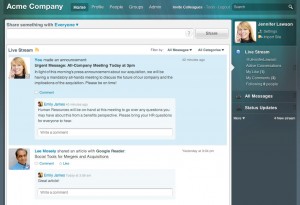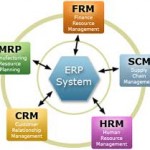
Socialcast is cloud-based social network for business that aims at easing communication between employees and vendors. Its platform allows employees to share ideas, documents, videos, and seek for help, when needed.
VMware bought Socialcast in May 2011, when the company was just starting to target business with its goal of easing internal communication. VMWare, with it new update in mid-April, transformed Socialcast from merely a commination tool, to a dream product for any Project Manager.
VMWare, through Socialcast, wants to alter the way businesses access information by improving business processes. The new update is especially important for Project Managers as it integrates multiple different systems, such as CRM (Customer Relationship Management), ERP (Enterprise Resource Planning), Sharepoint (document management software), email, and other applications. It creates a centralized workspace that helps Project Manager to keep track of deliverables and critical activities through communication with the team.
The new update also allows for instant messaging feature, called Socialcast Messenger, that is available on the platform as well as on mobile devices. While it is not an innovative feature, the IM keeps employees off using other massagers, such as Google Chat, and instead, keeps the communication centralized. Socialcast also allows employees to post updates, such a new security policy, and lets others in the company to comment on the post.
DePaul IT department, at which I am currently employed in as a Help Desk Analyst, uses similar features that Socialcast provides. We have a database, called DePaul University Knowledgebase or the “Wiki,” where specialists from different IT teams post documents and articles on various topics. This is especially helpful for my team because it aids in troubleshooting a technical problem. There are documents ranging from security polices to instructions on how to install various programs, such as SPSS, on DePaul machines. The Knowledgebase is especially useful for new employees, as they are not familiar with DePaul technology policies.

Source: http://www.socialcast.com/
We also use internal instant messaging to aid in communication between different teams. I can communicate with my supervisor instantly without the hassle of e-mails. I personally find the IM and the Knowledgebase very useful, as I don’t need to get away from my desk and take time from others to ask questions that can be otherwise answered with a support document.
While Socialcast is useful for employees to familiarize themselves with the company’s policies and seek help, how much does it look to you like Facebook, but just for business? Even the platform of Socialcast looks very much alike the Facebook wall. The idea of Socialcast new update is to centralize the workspace and minimize e-mail communication, or even eliminate meetings. Has the way we communicate changed so drastically that we no longer seek face-to-face interaction even in the workplace? What do you think of the new Project Management update to Socialcast?
—–
Sources:
VMware Adds Project Management, Secure IM to Socialcast Platform By Thor Olavsrud. April 18, 2013.
VMware Updates SocialCast With Private Messaging By Chris Preimesberger. April 22, 2013.


